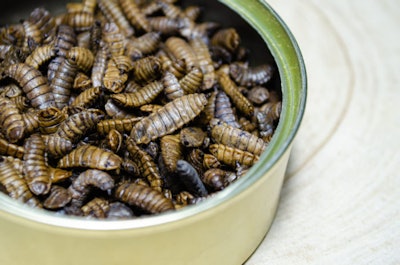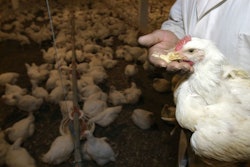
Texas State University’s Merritt Drewery is studying the use of black soldier fly larvae as a potential feed ingredient for beef cattle
PODCAST: Is BSFL a viable cattle feed ingredient? (18:29)
Ann Reus: Hello and welcome to the Feed Strategy podcast. I’m your host, Feed Strategy staff reporter Ann Reus.
Dr. Merritt Drewery is an assistant professor of applied animal science in the Department of Agricultural Sciences at Texas State University. Her research focuses on the identification of novel feedstuffs to enhance livestock production and, right now, she is examining the use of insects as a feed ingredient for cattle. She also is the project director for the 3eX-Ag program at Texas State, which supports educational activities for underrepresented students in agriculture.
Dr. Drewery, welcome to the podcast.
Drewery: Thanks for having me, Ann. I’m really excited.
Reus: You recently received a grant from the U.S. Department of Agriculture’s National Institute of Food and Agriculture to study insects as a potential feed ingredient for beef cattle. Tell me about this project.
Drewery: So, this project will start this upcoming fall, fall of 2021. And what we are going to do is, essentially, just evaluate different inclusion levels of black soldier fly larva, and the diet of cattle that would normally consume forage. And we’re going to compare that to conventional feedstuffs such as soybean milk or cottonseed meal to see how it performs.
Reus: What is the inclusion rate of insects in cattle diets? It might seem that you would need an awful lot of insect larvae to feed a herd of cattle.
Drewery: Yeah, absolutely. I get that question a lot. And when we think about the cattle industry, I think, we can obviously think about two sectors. And so you have those cattle that are perhaps in a cow-calf operation, or a stocker operation, and they’re primarily consuming forage. And then you have the cattle in the finishing phase in a feedlot. So, based on what sector we’re talking about, I think the inclusion would be very different. We are specifically focused on cattle consuming forage. And so, typically, in forage-based operations, protein supplements are offered to enhance forage utilization. And so, what we’re doing is evaluating black soldier fly larva as this potential protein supplement. And, actually, very little is used. If I just do like a back-of-the-napkin calculation, let’s say we have a 1,500-pound animal, I would only need to feed about two and a half pounds of the black soldier fly larva per day to each animal to really maximize that forage utilization. So, it seems like it would be a lot but because the black soldier fly larva is so protein rich, we actually don’t have to feed too much to really maximize the benefit.
Reus: So, you mentioned that black soldier fly larva is really protein rich, and I’ve noticed that a lot of work is being done with black soldier fly larvae for feed and pet food ingredients. Why is the BSF so attractive for this use?
Drewery: Yeah, so beyond just that nutrient profile, with that protein, that protein-rich profile, there are other reasons. Black soldier flies are really efficient growers. So, they have a great feed conversion ratio and they can also grow on nutrient-deplete substrates, things like even organic waste. Now, in the U.S., we can’t raise BSF on organic waste, if it’s going to enter, of course, the livestock feed or human food sector, but they do have that ability to be efficient growers on things that would otherwise be complete waste. Also, BSF are not a pest. So, if we think about rearing insects on a large scale, I don’t think anybody wants to be in an industrial business complex next to somebody that’s growing, maybe, cockroaches or termites or something like this. So, we have to be very aware of what kind of insects we are raising on a large scale. And BSF are very interesting because they are not a pest, the adults actually don’t have a functional mouth, so that means that they won’t bite. So, with that, perhaps the disease transmission potential is much lower. And, if a few get out of the facility, it won’t be a huge uproar from the neighboring companies, if you will. So, I think just that nutrient-rich profile combined with the fact that the adults are not a pest, and that they are efficient growers on really low-quality substrates makes them quite ideal.
Reus: Besides cattle, what other species have you found to be good candidates for an insect-based diet?
Drewery: Yeah, so BSF – and let’s talk about BSF specifically – as you know, there are so many insects out there, so we could talk about edible insects all day. But if we’re focused on black soldier fly larva, it is already approved in the U.S. by AAFCO to be fed in poultry diets, so you know, chickens, turkey, aquaculture, specifically salmon, salmonids, it’s and also swine diets, so pigs. So it’s already approved for those animals, and that, I think, is the result of a lot of research being conducted. And it makes a lot of sense, if you think about the natural diet of a chicken, they’re out on the ground, pecking around, seeking grub, worms and things like this. Obviously, fish come to the surface of the water and eat the insects. So, insect protein has already been evaluated with some degree of, I guess, rigor and thoroughness in these other animals. So, I think it’s a great candidate, of course, in those diets, but why we are evaluating it in cattle is because I think it could be even better utilized by cattle, which are ruminants. Unlike poultry, pigs and fish, cattle have a specialized digestive physiology. They are ruminants and, because of this, I think they will be able to better utilize black soldier fly larva, specifically the chitin content of black soldier fly larvae. So, it’s like a complex carbohydrate, and also the unbalanced essential amino acid profile. Neither of these will be as big of a hurdle or a challenge for cattle, just because of their specialized digestive system.
Reus: In your opinion, how important is it that we find ways to utilize alternatives to the typical protein sources in feed, such as soy and corn?
Drewery: I think it’s really important. The livestock production industry is commonly under fire and criticized for feeding crops or cereals to food-producing animals when they could be fed, in fact, to humans. And so, whether that practice is good or bad, there is still scrutiny and the consumers, the U.S. consumers, just don’t like that. So, also, these crops, soy, you mentioned, that are fed to livestock, they require significant natural resource inputs. So, they require a lot of agricultural land, but also water inputs. And in some cases, these conventional crops, if you will, are associated with, let’s say, deforestation, or other negative environmental implications. So, I think it’s really important to find alternative feeds that do not require the same natural resource inputs and also will not compete in the human food sector. And that’s why I think insects are uniquely positioned to be that feed. Because although insects are really nutrient dense, as we’ve talked about, consumers in the Western world, don’t want to eat them. Like, Ann, I don’t know how adventurous you are in your eating habits. I’m pretty adventurous, but there’s just something about, you know, snacking on a whole roasted cricket that just doesn’t sit well with me.
Reus: Better than a live one, though, I’m sure.
Drewery: Better than alive. I wouldn’t know – I’ve done the whole roasted thing. But anyway, and I’m on that like highly adventures eater spectrum. So, I just don’t think Western consumers will adopt insects in their diet. So how can we still utilize that great protein source that insects represent? I think, feeding it to livestock, so then we’re still producing food for Western consumers that they find fit for consumption. I think that’s the best route and has a lot of promise.
Reus: So, yeah, besides that “ick” factor, I know insect ingredients in feed have challenges such as processing. What challenges have you personally experienced in using insect-based ingredients in animal feed?
Drewery: A lot of it is that the insect-rearing industry is kind of young, it’s not necessarily in its infancy, but it’s young. And so there have been certain, I guess, insects or ingredients that I have wanted to source and it’s been a little bit more difficult. But that’s why I think this research is important, because I think that the insect-rearing industry is seeing significant growth. And so I think that it’s critical right now to inform these companies, and these investors of potential outlets for their products. As I’ve mentioned, I really, I feel that a lot of the industry wants to produce insects for human food consumption, but I just don’t think that demand will be there. So, I’m hoping that conducting this research in livestock, specifically cattle, will inform them of a potential outlet for their product. So, I guess to answer your question, just because the industry is kind of young, it’s been difficult to source, the exact insects that I’m interested in. But also, I think that that’s been complicated by COVID. We’ve been conducting this research during COVID and so I don’t know if that’s a true issue or not. The other thing that I’m not sure if it’s a barrier or not, is consumer perception. So there have been some studies conducted in non-U.S. regions, so in Europe, specifically, where consumers just say they’re still grossed out by the fact that they could potentially eat chicken that has been fed insects as part of their diet. And that’s really interesting to me, because, of course, insects are the natural diet of chickens. So, I think consumers still have that “ick” factor. But I don’t know that that will actually be a barrier or not, it’ll just be something interesting. And we are conducting kind of a more social science-oriented study in the U.S. to say, what are consumer attitudes towards animal products that have been harvested from livestock fed insects to see, how do consumers feel about this? And beyond just, are they disgusted by it or not? Is it an ethical practice? That’s something that’s really interesting as well.
Reus: Well, on that note, what do you think is the outlook for insects as feed ingredients, on the regulatory front and in the acceptance and use in animal diets?
Drewery: I think on the regulatory front, as I mentioned, AAFCO has already approved BSFL –black soldier fly larva – to be a feed in the U.S. for different livestock. And of course, there’s parameters around that the BSFL have to be fed on feed- or food-grade materials. They can’t be fed on, let’s say, organic waste or something like that, like human waste. So I think the regulatory outlook is good. I think that the barrier to why they haven’t been approved in cattle or other ruminant diets, like goats or sheep, is simply because that research hasn’t been conducted. You know, we’re kind of the first to do these feeding trials, to my knowledge anyway, so I think that once we conduct this research and show that it’s safe, and there’s not detrimental effects, hopefully that’ll push the regulatory front along. And of course, we’re just talking about BSFL. I think that other edible insects have probably also been approved in feed. So, I really think we just need a little bit of consumer outreach and education. And I’ve realized – I don’t know about you, Ann – but when I’m working on something, I kind of get blinders on and forget that I’ve learned so much about it. And I’m so integrated in this world and the person sitting next to me on the bus or whatever has been researching this for a month straight and they know nothing about it. So, I think when that person next to me on the bus first hears that we’re feeding insects to livestock, they don’t even understand. They’re like, OK, are the insects alive? Are they, like, trapped in a net with the with the cattle? Like, what is happening? And it just seems like a foreign concept to them. So, I think that we just need to talk about this – and that’s why I’m so happy you invited me on the podcast – and educate consumers about this and say this is kind of what it looks like, here are some pictures, here are the environmental benefits, perhaps the sustainability benefits and whatever benefits there are, here are potential risks so that consumers can then make an informed decision as to whether they accept it or not. But I think, at the end of the day, once we start having these conversations, and this research hits more mainstream media, that consumers will accept it, and it will become a norm.
Reus: Now, you mentioned that you’re also interested in social sciences, and you’re involved with Texas State University’s 3eX-Ag program. Can you tell me a little bit about that program and what it aims to do?
Drewery: 3eX-Ag is a USDA-funded program. And what we are doing is trying to position underrepresented students for academic and professional success. And, so, an underrepresented student is a minority student, or perhaps a first-gen student, meaning their first in their family to go to college, or economically disadvantaged. Anyway, we are trying to integrate these students in their research laboratory, and basically just give them experiences that will look great on their resume, but also allow them to maybe get some of these really competitive jobs after graduation, or perhaps go to graduate school, pursue a Master’s or a PhD degree. So, during COVID, 3eX-Ag has involved quite a few undergraduates, and we’ve been focused on social science research, just so we can socially distance but still get things done, and we’ve been exploring a variety of topics but, as it’s related to BSFL, as I mentioned, we are about to launch a survey that is meant for U.S. consumers and basically just assessing consumer attitude and understanding of insect as livestock feed so we can investigate, will this really be a barrier or not? How do consumers feel about this? And hopefully start some of those interesting conversations so we can start this outreach and education.
Reus: Well, thank you, Dr. Drewery, for taking the time to talk with me today, and good luck with your research. I’m looking forward to what you find. And thank you to the listeners for tuning in.














